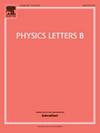荷电霍恩德斯基黑洞的扩展热力学分析
IF 4.3
2区 物理与天体物理
Q1 ASTRONOMY & ASTROPHYSICS
引用次数: 0
摘要
根据爱因斯坦-霍恩德斯基-麦克斯韦理论,对质量为m、电荷为q的荷电黑洞(CHB)进行了热力学分析。有两个解分支:一个是CHB解分支,另一个是裸奇点解分支。CHB的热力学行为与Reissner-Nordström黑洞相似,但它的亥姆霍兹自由能总是正的。如果将NS点作为极值点,则亥姆霍兹自由能始终为负,这意味着在任何地方都可以达到全局稳定区域。对于NS,它的温度有一个最大值,它的热容一直为负而没有戴维斯点,它的自由能随电荷q的增加而无限制地减小。本文章由计算机程序翻译,如有差异,请以英文原文为准。
Extended thermodynamic analysis of a charged Horndeski black hole
We perform the thermodynamic analysis of a charged Horndeski black hole (CHB) with mass m and charge q obtained from the Einstein-Horndeski-Maxwell theory. There are two solution branches: one is for the CHB and the other is for the naked singularity (NS). Thermodynamic behavior for the CHB is similar to that for the Reissner-Nordström black hole but its Helmholtz free energy is always positive. If the NS point is included as an extremal point, then the Helmholtz free energy is always negative, implying that the globally stable region is achieved anywhere. For the NS, its temperature has a maximum point, its heat capacity remains negative without having Davies point, and its free energy decreases without limitation as the charge q increases.
求助全文
通过发布文献求助,成功后即可免费获取论文全文。
去求助
来源期刊

Physics Letters B
物理-物理:综合
CiteScore
9.10
自引率
6.80%
发文量
647
审稿时长
3 months
期刊介绍:
Physics Letters B ensures the rapid publication of important new results in particle physics, nuclear physics and cosmology. Specialized editors are responsible for contributions in experimental nuclear physics, theoretical nuclear physics, experimental high-energy physics, theoretical high-energy physics, and astrophysics.
 求助内容:
求助内容: 应助结果提醒方式:
应助结果提醒方式:


